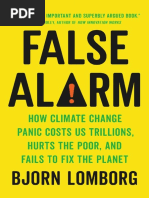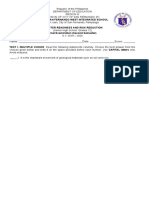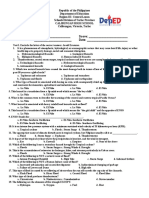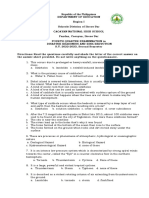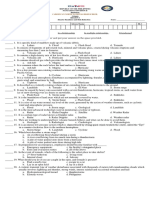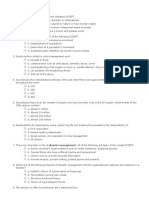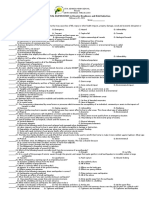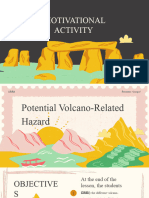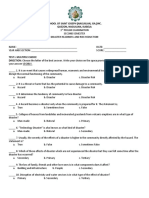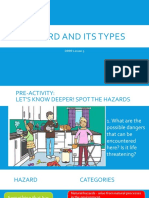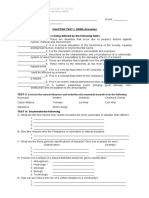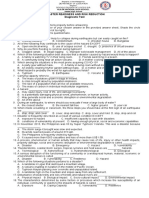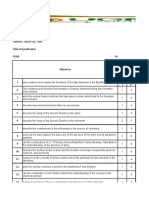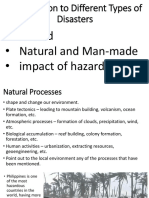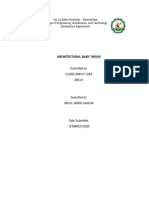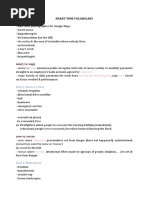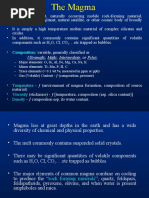Name: - Section: - Date: - Score
Name: - Section: - Date: - Score
Uploaded by
BRENDEL SACARISCopyright:
Available Formats
Name: - Section: - Date: - Score
Name: - Section: - Date: - Score
Uploaded by
BRENDEL SACARISOriginal Description:
Original Title
Copyright
Available Formats
Share this document
Did you find this document useful?
Is this content inappropriate?
Copyright:
Available Formats
Name: - Section: - Date: - Score
Name: - Section: - Date: - Score
Uploaded by
BRENDEL SACARISCopyright:
Available Formats
Republic of the Philippines
Department of Education
Region VII, Central Visayas
Division of Talisay City
TABUNOK NATIONAL HIGH SCHOOL
Tabunok, Talisay City, Cebu
DISASTER RISK REDUCTION AND MANAGEMENT
FINAL EXAM
Name:________________________________ Section:__________ Date:_________ Score:_______
DIRECTION : Encircle the letter of the correct answer.
Test I.
1. The opening in the volcano from where lava comes out.
A. Ash Cloud B. Vent C. Magma D. Crater
2. Conduit’s part that ejects lava and volcanic ash.
A. Throat B. Conduit C. Ash Cloud D. Summit
3. A cloud of ash formed by volcanic explosions.
A. Magma C. Conduit
B. Summit D. Ash cloud
4. Which is NOT volcano related hazard
A. Volcanic gasses B. Earthquake
C. Lahar D. Ash Fall
5. A flat piece of rock which forms by hardening of magma in a crack in a volcano
A. Crater B. Throat C. Sill D. Ash
6. Molten rocks under the surface of the earth
A. Ash Cloud C. Crater
B. Summit D. Magma
7. A small parts of lava or rocks which are shot in the air by explosion.
A. Magma B. Throat C. Ash Cloud D. Ash
8. How many active and inactive volcano here in the Philippines.
A. 22 C. 1,500
B. 300 D. 500
9. ___________ move rapidly down valleys like rivers of concrete.
A. Pyroclastic Flows
B. Ash Fall
C. Lahar
D. Volcanic Gasses
10. How many active volcano here in the Philippines
A. 22 B. 1,500 C. 300 D. 500
11. Producing suspensions of fine-grained particles in air water
A. Lava Flows B. Ballistic Projectiles
C. Volcanic Gasses D. Pyroclastic flows
12. Can pose significant disruption and damage to: water, building, transportation, power supply,
communications equipment, agriculture.
A. Lava FlowsB. Ash fall C. Storm surge D. Thunderstorm
13. Translate from Spanish as ‘boy-child’.
A. Thunderstorm C. Tropical cyclone
B. La Niña D. El Niño
14. Translate from Spanish as ‘girl-child’.
A. Thunderstorm C. Tropical cyclone
B. La Niña D. El Niño
15. Filipinos usually call these climate disturbances “typhoons”
A. Tropical cyclone
B. Thunderstorm
C. Floods
D. Storm surge
16. Which of the following does not belong to the group of manmade causes
A. Informal settler’s C. Deforestation
B. Indiscriminate dumping of garbage D. None of the above
17. It is a flood caused by the overflowing of rivers when the run-off exceeds the capacity of the channels.
A. Flash Flood C. River Flood
B. Coastal Flood D. None of the above
18. It is a flood caused by a very short period of unusually heavy rainfall.
A. Flash Flood C. River Flood
B. Coastal Flood D. None of the above
19. It is a flood occurs when strong onshore winds push the water inland. The rise in the sea level also cause
flooding of the low-lying coastal areas.
A. Flash Flood C. River Flood
B. Coastal Flood D. None of the above
20. ________ are icy crystals falling from a thunderstorm.
A. Hailstone B. Thunderstorm C. Storm surge D. Lightning
21. The precipitation decreases its intensity and clouds begin to dissipate.
A. Hailstone B. Thunderstorm C. Storm surge D. Lightning
22. It is a condition that favor fire development or growth.
A. Hydrometeorological hazards B. Fire hazard
C. Volcanic hazard D. All of the above
23. It is contain water for use against fires involving ordinary combustibles like paper, wood, cloth and most
plastics.
A. Class A B. Class B C. Class C D. Class D
24. It is use dry chemicals to put out fires caused by gasoline, oil and solvents.
A. Class A B. Class B C. Class C D. Class D
25. It is contains carbon dioxide for use against electrical fires.
A. Class A B. Class B C. Class C D. Class D
26. It is spray dry powder on combustible metal like magnesium, titanium, aluminum, sodium, and potassium.
A. Class A B. Class B C. Class C D. Class D
27. It is use a wet, potassium acetate-based, low pH agent to put out “cooking” fires in which there are animal
or vegetable oils and fats.
A. Class A B. Class B C. Class K D. Class D
28. Require a flow of air in order to work well
A. Smoke detectors B. Heat detectors
C. Flame detectors D. All of the above
29. Detect fires where there is no smoke activated by the significant increase of temperature associated with
fire.
A. Smoke detectors B. Heat detectors
C. Flame detectors D. All of the above
30. React to the movement of flames.
A. Smoke detectors B. Heat detectors
C. Flame detectors D. All of the above
31. Which does not belong to fire detection devices
A. Smoke detectors B. Heat detectors
C. Flame detectors D. Fire Extinguisher
32. It is a type of mitigation refers to increasing the resistance to the hazard and reducing vulnerability.
A. Primary Mitigation B. Secondary Mitigation
C. Tertiary Mitigation D. All of the above
33. It is a type of mitigation refers to reducing effects of the hazard (preparedness).
A. Primary Mitigation B. Secondary Mitigation
C. Tertiary Mitigation D. All of the above
34. The first step in disaster mitigation is to identify areas that are at risk to hazard.
A. Risk Identification B. Land-Use Planning
C. Structural and Non-Structural D. Disaster relief and Rehabilitation
35. _________ includes the mapping of disaster prone area which should contain number of livestock per unit
area, crop density, population density, road network, location of shelter etc.
A. Risk Identification B. Land-Use Planning
C. Structural and Non-Structural D. Disaster relief and Rehabilitation
36. Mitigation measures may involve construction (e.g. dykes and flood protection walls, and also ecosystem-
based approaches to flood and erosion control, such as planting mangrove forests) and non-material measures
(e.g. land-use restrictions in flood risk areas).
A. Risk Identification B. Land-Use Planning
C. Structural and Non-Structural D. Disaster relief and Rehabilitation
37. Supply emergency humanitarian aid to victims for survival and relocate the peoples whose residence have
been destroyed very badly, inappropriate for living.
A. Risk Identification B. Land-Use Planning
C. Structural and Non-Structural D. Disaster relief and Rehabilitation
38. Media is effective means to circulate the news and bulletins about hazard warning and mitigation processes.
A. Disaster Management Training and education
B. Institutional capacity building
C. Role of media in Disaster Risk Reduction
D. Disaster relief and Rehabilitation
39. Trained up group of personnel need to be formed in local, national and regional context to mitigate and
reduce disaster risk and damages.
A. Disaster Management Training and education
B. Institutional capacity building
C. Role of media in Disaster Risk Reduction
D. Disaster relief and Rehabilitation
40. Several institutional bodies are engaged with disaster mitigation processes such as local community,
organization, local and national government, NGO’s, international organization etc.
A. Disaster Management Training and education
B. Institutional capacity building
C. Role of media in Disaster Risk Reduction
D. Disaster relief and Rehabilitation
Directions: Write the letter of the space provided
Test II. Matching type
Column A Column B
_____1. A small parts of lava or rocks which are shot in the air by explosion A. Ballistic Projectiles
_____2. A flat piece of rock which forms by hardening of magma in a crack in a volcano B. 22
_____3. The opening in the volcano from where lava comes out. C. Secondary Mitigation
_____4. Molten rocks under the surface of the earth D. Primary Mitigation
_____5. Conduit’s part that ejects lava and volcanic ash. E. 300.
_____6. Producing suspensions of fine-grained particles in air water F. Ash
_____7. Translate from Spanish as ‘boy-child G. Sill
_____8. Translate from Spanish as ‘girl-child H. Lahar
_____9. Filipinos usually call these climate disturbances “typhoons” I. Class A
_____10. It is a flood caused by a very short period of unusually heavy rainfall. J. Class B
_____11.________ are icy crystals falling from a thunderstorm. K. Class C
_____12. The precipitation decreases its intensity and clouds begin to dissipate. L. Class K
_____13. It is a condition that favor fire development or growth. M. Vent
_____14. It is use dry chemicals to put out fires caused by gasoline, oil and solvents. N. Magma
_____15. Require a flow of air in order to work well O. Throat
_____16. React to the movement of flames. P. El Niño
_____17. It is contains carbon dioxide for use against electrical fires. Q. La Niña
_____18. It is a type of mitigation refers to reducing effects of the hazard (preparedness). R. Tropical Cyclone
_____19. ___________ move rapidly down valleys like rivers of concrete. S. Flash Flood
_____20. How many active and inactive volcano here in the Philippines. T. Hailstone
U. Thunderstorm
V. Fire Hazard
W. Smoke Detectors
X. Flame Detectors
You might also like
- Bjorn Lomborg - False Alarm - How Climate Change Panic Costs Us Trillions, Hurts The Poor, and Fails To Fix The Planet-Basic Books (2020) - CompressedDocument339 pagesBjorn Lomborg - False Alarm - How Climate Change Panic Costs Us Trillions, Hurts The Poor, and Fails To Fix The Planet-Basic Books (2020) - Compressedanahy82% (11)
- Midterm Exam DRRR SY 2018 2019Document6 pagesMidterm Exam DRRR SY 2018 2019Janix MagbanuaNo ratings yet
- q4 DRRR 12 With AnswerDocument22 pagesq4 DRRR 12 With AnswerRonellaSabado100% (3)
- Sat Practice Test 9 Writing and Language Assistive TechnologyDocument60 pagesSat Practice Test 9 Writing and Language Assistive TechnologyAhmed Hesham El FikyNo ratings yet
- NAME: - COURSE/SECTION: - SCORE: Long Quiz in DRRRDocument3 pagesNAME: - COURSE/SECTION: - SCORE: Long Quiz in DRRRRenz GaraisNo ratings yet
- Name: - Score: - Year and Section: - DateDocument2 pagesName: - Score: - Year and Section: - DateEmerson Mercado GalanoNo ratings yet
- 1st Quarter ExamDocument3 pages1st Quarter Examrheza oropaNo ratings yet
- DRRR q4 ExaminationDocument5 pagesDRRR q4 ExaminationLAURENCE CASILDO100% (1)
- DRRR Exam.Document7 pagesDRRR Exam.Claudette M.Magararu100% (1)
- Midterm Exam DRRRDocument2 pagesMidterm Exam DRRRManuel Paulo AcogidoNo ratings yet
- DRRRDocument3 pagesDRRRangeline antonioNo ratings yet
- Disaster Risk Reducation - Reviewer EXAM PDFDocument2 pagesDisaster Risk Reducation - Reviewer EXAM PDFElectona Kai SairNo ratings yet
- 4th Prelim 2020Document14 pages4th Prelim 2020Mira VeranoNo ratings yet
- Dalupaon National High School: Department of EducationDocument3 pagesDalupaon National High School: Department of Educationjeanette PradesNo ratings yet
- DRRR Final Exam 2020Document3 pagesDRRR Final Exam 2020Argie Joy Marie AmpolNo ratings yet
- DRRR 4TH Quarter Exam.Document4 pagesDRRR 4TH Quarter Exam.Faxman Cavan SingcoNo ratings yet
- Summative Test in DRRRDocument3 pagesSummative Test in DRRRGericNo ratings yet
- On Disaster Readiness & Risk Reduction - First Quarter: Table of Specification For A 50 - Item TestDocument4 pagesOn Disaster Readiness & Risk Reduction - First Quarter: Table of Specification For A 50 - Item TestLiezel CauilanNo ratings yet
- PPPR4Document2 pagesPPPR4Pearl Cabigas0% (1)
- First Summative Test DRRR 4th Quarter New NormalDocument2 pagesFirst Summative Test DRRR 4th Quarter New NormalRenzelle Guilaran GerocheNo ratings yet
- Final Examination in Cs110 - DRRR - Answer KeyDocument10 pagesFinal Examination in Cs110 - DRRR - Answer KeyPrincess Ira SantillanNo ratings yet
- 1st Quarter Exam in DRRRDocument3 pages1st Quarter Exam in DRRRNelmar Araneta100% (1)
- 3rd Final ExamDocument9 pages3rd Final ExamMira Verano100% (1)
- DRRRDocument16 pagesDRRRAlexa Feliz De PedroNo ratings yet
- DRRR - Q2 - Summative 3Document4 pagesDRRR - Q2 - Summative 3Billy Jasper DomingoNo ratings yet
- Hazards, Exposure, and Vulnerabilities From ActualDocument37 pagesHazards, Exposure, and Vulnerabilities From ActualJaine LuzNo ratings yet
- DRR11Document8 pagesDRR11Llermi Liborio100% (1)
- Summative Test - Written Work #1: Republic of The Philippines Department of EducationDocument2 pagesSummative Test - Written Work #1: Republic of The Philippines Department of EducationJoshua VicenteNo ratings yet
- DRR1Document2 pagesDRR1MASH100% (1)
- Blessed Christian School de Sta. Rosa Inc.: Rizal Blvd. Balibago, City of Santa Rosa SY: 2019-2020Document4 pagesBlessed Christian School de Sta. Rosa Inc.: Rizal Blvd. Balibago, City of Santa Rosa SY: 2019-2020Angelyn Lingatong100% (1)
- Hydrometeorological HazardsDocument115 pagesHydrometeorological HazardsKim DiazNo ratings yet
- School of Saint Joseph (Naguilian, Isa.) Inc. Quezon, Naguilian, IsabelaDocument2 pagesSchool of Saint Joseph (Naguilian, Isa.) Inc. Quezon, Naguilian, IsabelaYvette Marie Yaneza NicolasNo ratings yet
- DRRR Activity Sheet 56Document4 pagesDRRR Activity Sheet 56Sam Kim 3100% (1)
- QUIZDocument4 pagesQUIZrheza oropaNo ratings yet
- Table of Specification Disaster Readiness and Risk Reduction 4th Quarter FINAL EXAMDocument1 pageTable of Specification Disaster Readiness and Risk Reduction 4th Quarter FINAL EXAMRichard CortezNo ratings yet
- Test Questionnaire Disaster Readiness and Reduction 3rd QuarterDocument4 pagesTest Questionnaire Disaster Readiness and Reduction 3rd Quarterzhaninakaye100% (1)
- Basic Concept of HazardDocument5 pagesBasic Concept of HazardRosely PaquiteNo ratings yet
- DRRR Q2 Exam TOS 20 ItemsDocument2 pagesDRRR Q2 Exam TOS 20 ItemsJeffrey OralizaNo ratings yet
- Graphic Organizers For DRRRDocument7 pagesGraphic Organizers For DRRRKate Bandohan100% (1)
- DRRR Q2 Exam 20 ItemsDocument2 pagesDRRR Q2 Exam 20 ItemsJeffrey OralizaNo ratings yet
- DRRR Q1 WK7 40 CopiesDocument16 pagesDRRR Q1 WK7 40 CopiesRubilyn RamosNo ratings yet
- Long Test 3RD Grading DRRRDocument2 pagesLong Test 3RD Grading DRRRmaria pamela m.surbanNo ratings yet
- DRRRDocument17 pagesDRRRPatrick L. RondinaNo ratings yet
- Midterm Examination: Disaster Readiness and Risk ReductionDocument3 pagesMidterm Examination: Disaster Readiness and Risk ReductionHarold Nalla Husayan100% (1)
- Detailed Lesson Plan For DRRR April 08, 2022Document5 pagesDetailed Lesson Plan For DRRR April 08, 2022allan torreonNo ratings yet
- Disaster Readiness and Risk Reduction Quarter ExamDocument5 pagesDisaster Readiness and Risk Reduction Quarter ExamLAURENCE CASILDONo ratings yet
- Quiz 1 DRRRDocument1 pageQuiz 1 DRRRGail GailNo ratings yet
- Q4 LESSON 4 (Disaster Risk Reduction)Document8 pagesQ4 LESSON 4 (Disaster Risk Reduction)WhySoSerious?No ratings yet
- Q3 DRRR L5-Hazard and Its TypesDocument18 pagesQ3 DRRR L5-Hazard and Its TypesRuel PerezNo ratings yet
- 1ST Q ExamDocument4 pages1ST Q ExamVhe-un LageraNo ratings yet
- Notes in DRRR First Periodical ExamDocument7 pagesNotes in DRRR First Periodical ExamCharline A. Radislao100% (1)
- DRRR Chapter Test On DisasterDocument2 pagesDRRR Chapter Test On DisasterVhiinXoii BeriosoNo ratings yet
- DRRR - Module6 (Week10-11)Document19 pagesDRRR - Module6 (Week10-11)starlightzNo ratings yet
- DRRR ReviewerDocument8 pagesDRRR ReviewerCatherine ManaloNo ratings yet
- I. Multiple Choice: Write The Letter of Your Answer On The Blank Before The NumberDocument2 pagesI. Multiple Choice: Write The Letter of Your Answer On The Blank Before The NumberLeomar PascuaNo ratings yet
- DRRR Diagnostic TestDocument3 pagesDRRR Diagnostic TestJuliane Rebecca Pitlongay100% (1)
- DRRR Reviewer 3rd QuarterDocument8 pagesDRRR Reviewer 3rd QuarterApril Joy T. GrijaldoNo ratings yet
- Week 3: Potential Hydrometeorological HazardDocument4 pagesWeek 3: Potential Hydrometeorological HazardJamie Liliany AlferezNo ratings yet
- I. Objectives: Grade 12 Charity DRRR 4 Quarter/2 SemesterDocument4 pagesI. Objectives: Grade 12 Charity DRRR 4 Quarter/2 SemesterMichael DeniegaNo ratings yet
- Disaster Readiness and Risk Reduction - Grade 12Document5 pagesDisaster Readiness and Risk Reduction - Grade 12Rizalyn GarciaNo ratings yet
- DRR 12 1st Long TestDocument3 pagesDRR 12 1st Long TestRoy CanoyNo ratings yet
- DRRR RTPDocument5 pagesDRRR RTPLyric BantilesNo ratings yet
- I. Direction: Read The Questions Carefully. Encircle The Letter of The Best AnswerDocument4 pagesI. Direction: Read The Questions Carefully. Encircle The Letter of The Best AnswerBRENDEL SACARIS0% (1)
- Emp Tech 1Document30 pagesEmp Tech 1BRENDEL SACARISNo ratings yet
- Tos DRRMDocument7 pagesTos DRRMBRENDEL SACARISNo ratings yet
- Mil 4Document7 pagesMil 4BRENDEL SACARISNo ratings yet
- Media and Information Literacy Types of Media:: Print, Broadcast, New Media (Lec)Document6 pagesMedia and Information Literacy Types of Media:: Print, Broadcast, New Media (Lec)BRENDEL SACARISNo ratings yet
- Mil 5Document7 pagesMil 5BRENDEL SACARIS0% (1)
- Lesson 1Document16 pagesLesson 1BRENDEL SACARISNo ratings yet
- Lesson 1Document16 pagesLesson 1BRENDEL SACARISNo ratings yet
- Exam 1Document2 pagesExam 1BRENDEL SACARISNo ratings yet
- Mil 12 Group 4 Gas 12 FinalDocument6 pagesMil 12 Group 4 Gas 12 FinalBRENDEL SACARIS100% (6)
- Mil 1Document11 pagesMil 1BRENDEL SACARIS100% (1)
- Mil 13Document11 pagesMil 13BRENDEL SACARISNo ratings yet
- Name: - Section: - Date: - ScoreDocument4 pagesName: - Section: - Date: - ScoreBRENDEL SACARISNo ratings yet
- Unit 11 Apartments HousesDocument2 pagesUnit 11 Apartments HousesBrahan karimNo ratings yet
- Science Project - A Closer Look at The Earth - 6CDocument2 pagesScience Project - A Closer Look at The Earth - 6CMehjabeen ShaikNo ratings yet
- Multimedia Test International Geography Olympiad 2008: Name: COUNTRYDocument7 pagesMultimedia Test International Geography Olympiad 2008: Name: COUNTRYVlad Bogdan MănicaNo ratings yet
- Alcover-Cherryl-G5-Q3-Week 2Document8 pagesAlcover-Cherryl-G5-Q3-Week 2Judhyluna PatalitaNo ratings yet
- Group 4 Endogenic and Exogenic ProcessesDocument42 pagesGroup 4 Endogenic and Exogenic ProcessesPrincess PabualanNo ratings yet
- Introductory Material: Science (Quarter III)Document1 pageIntroductory Material: Science (Quarter III)MARITESS COLLADONo ratings yet
- Dinosaurs 123Document25 pagesDinosaurs 123Caturya Windy Cita MaellyaNo ratings yet
- Landscapes: Geomorphology (The Study of The Earth's Landscapes and The Processes That ShapeDocument18 pagesLandscapes: Geomorphology (The Study of The Earth's Landscapes and The Processes That ShapejalexvegaNo ratings yet
- Symposium Presentation On Disaster PreparednessDocument26 pagesSymposium Presentation On Disaster Preparednesskyla marie lamboNo ratings yet
- Baby ThesisDocument2 pagesBaby ThesisclareableNo ratings yet
- DRRR Reviewer OCT QuizDocument4 pagesDRRR Reviewer OCT QuizLoui ChiNo ratings yet
- ScriptDocument2 pagesScriptdemiarcrisisNo ratings yet
- Nagcarlan - Abo-Bukal Es - Fire ContingencyDocument27 pagesNagcarlan - Abo-Bukal Es - Fire ContingencyMyra AseguradoNo ratings yet
- VolcanoDocument4 pagesVolcanoRona Carmen LabradorNo ratings yet
- Hazardassessment of Pitpitan Bulacan BulacanDocument6 pagesHazardassessment of Pitpitan Bulacan BulacanEmby BinoeNo ratings yet
- Complete Physical Geography For Every ExamDocument136 pagesComplete Physical Geography For Every Examakun6356No ratings yet
- Cooperation - RMR Assignment #1 Volcanoes and Earthquakes - RioDocument3 pagesCooperation - RMR Assignment #1 Volcanoes and Earthquakes - RioMhar Angelo CantonNo ratings yet
- Effects of Volcanic EruptionDocument34 pagesEffects of Volcanic EruptionJuvielyn RazNo ratings yet
- 21 PLAXIS BulletinDocument24 pages21 PLAXIS BulletinanniecvNo ratings yet
- A Steady Source of PowerDocument1 pageA Steady Source of PowerHonolulu Star-AdvertiserNo ratings yet
- Science 9 Unit 3 Module 1Document3 pagesScience 9 Unit 3 Module 1Jeddie SuanNo ratings yet
- Reading Passages-Science Level 4Document24 pagesReading Passages-Science Level 4Anh Nguyễn QuangNo ratings yet
- Unit 1: Just The Job: Smart Time VocabularyDocument5 pagesUnit 1: Just The Job: Smart Time VocabularyLam LamNo ratings yet
- Sains SPM Chapter 3 Form 5Document10 pagesSains SPM Chapter 3 Form 5Sensei J-dai89% (18)
- PDF - Types of Volcanoes (Based On Structure)Document73 pagesPDF - Types of Volcanoes (Based On Structure)Trinity MarieNo ratings yet
- Geology of MatanogDocument4 pagesGeology of MatanogMrose GabuyoNo ratings yet
- Ultramafic, Mafic, Intermediate, or Felsic: - CompositionDocument13 pagesUltramafic, Mafic, Intermediate, or Felsic: - CompositionArturo EguezNo ratings yet
- IB GEO GUIDE 2019 Exams - CurriculumDocument24 pagesIB GEO GUIDE 2019 Exams - CurriculumggyygesyNo ratings yet
